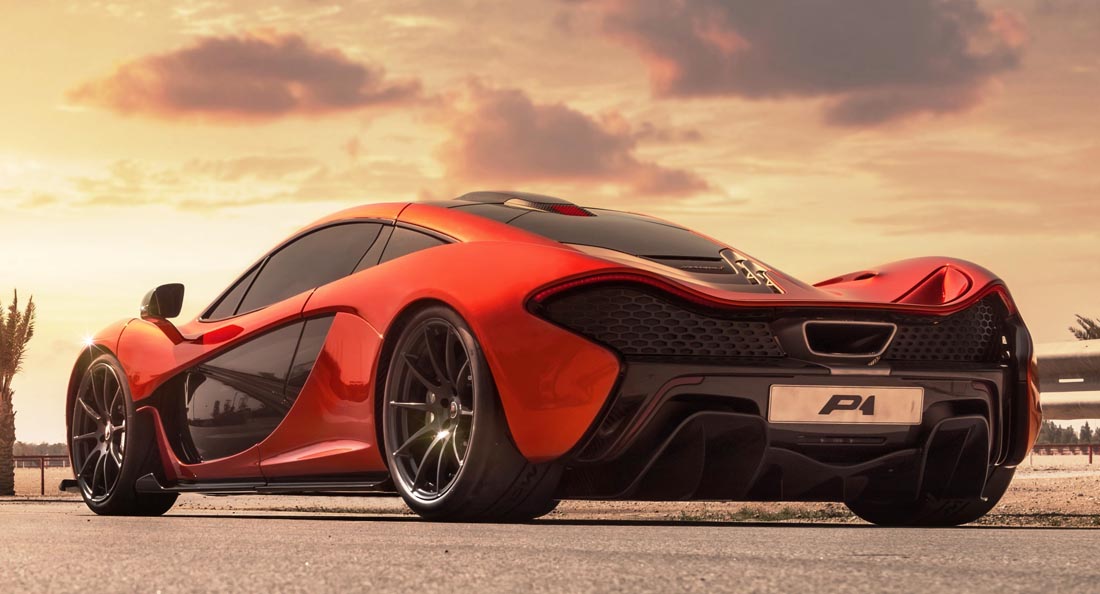
The astonishing new McLaren P1™, which debuted in production form at the 2013 Geneva Motor Show, has a clear goal – to be the best driver’s car in the world on road and track. To achieve this objective, McLaren is using all of its 50 years of racing experience and success, especially in the fields of aerodynamics and lightweight carbon fibre technology.
The result is a car that has an unprecedented amount of downforce for a road vehicle: similar levels to a GT3 racing car and yet with even greater ground effect. This downforce not only boosts cornering and braking performance. It also helps balance, stability and driveability at all speeds.
‘McLaren introduced the carbon fibre chassis to the world of Formula 1 in 1981 with the MP4/1, and we had the first carbon-bodied road car,’ says McLaren Automotive Executive Chairman Ron Dennis. ‘We have always been at the cutting edge of vehicle aerodynamics, and all of this experience has gone into the new McLaren P1™. Twenty years ago, with the McLaren F1, we raised the supercar performance bar. With the McLaren P1™, we have redefined it once more.’

The best driver’s car in the world must also have exceptional straight-line performance and instant throttle response. To deliver this, the McLaren P1™ uses an innovative IPAS petrol-electric powertrain comprising a substantially revised 3.8-litre twin-turbo V8 petrol engine, coupled to a single electric motor, collectively known as M838TQ. Combined power output is 916 PS (903 hp). As important as absolute power is the electric motor’s ability to provide instant torque, making the powertrain superbly responsive. It is also amazingly efficient. Carbon dioxide emissions are less than 200g/km, and it can cover more than 10 km in electric-only mode.
Top speed is electronically limited to 350 km/h (217 mph), with the 0-100 km/h (62 mph) in 2.8 seconds, 200 km/h (124 mph) in 6.8 seconds, and 300 km/h (186 mph) in just 16.5 seconds.
‘We believe the McLaren P1™ is the most exciting, capable, technologically advanced and most dynamically accomplished supercar ever made,’ says McLaren P1™ programme director, Paul Mackenzie. ‘It may not be the fastest car in the world in absolute top speed, but that was never our goal. Rather, we believe it is the fastest ever production car on a racing circuit, a much more important technical statement, and far more relevant for on-road driving. It is a true test of a supercar’s all-round ability. Plus many owners will use the car on the circuit, at special track and test days.’
The astonishing technology developed for the McLaren P1™ includes active aerodynamics and adjustable suspension – both now banned in Formula 1, due to being seen to give a performance advantage. Airflow is optimised around the body through the use of an active wing and underbody devices. The adjustable rear wing can extend from the bodywork by 120mm on road, up to 300mm on the race track, maximising the levels of downforce. The wing is directly inspired by Formula 1 design, with the intersection of the double element rear wing and design of the endplates being the same as that on the 2008 championship winning MP4-23.
In addition, the McLaren P1™ also features adjustable ride height as part of the new hydro-pneumatic suspension. The revolutionary RaceActive Chassis Control (RCC) can lower the car by 50mm in Race mode, to produce ground effect aerodynamics. It also features adaptive spring rates, roll control, pitch control and damping, all providing a huge range of adjustment, making the McLaren P1™ perfect for either road or track. In Race mode, the spring rates stiffen by 300 per cent, allowing the McLaren P1™ to corner at more than 2g.
Formula 1-inspired technology permeates the McLaren P1™. The revolutionary new carbon fibre MonoCage monocoque forms a complete structure incorporating the vehicle’s roof and its distinctive snorkel air intake – a styling feature inspired by the McLaren F1 road car.
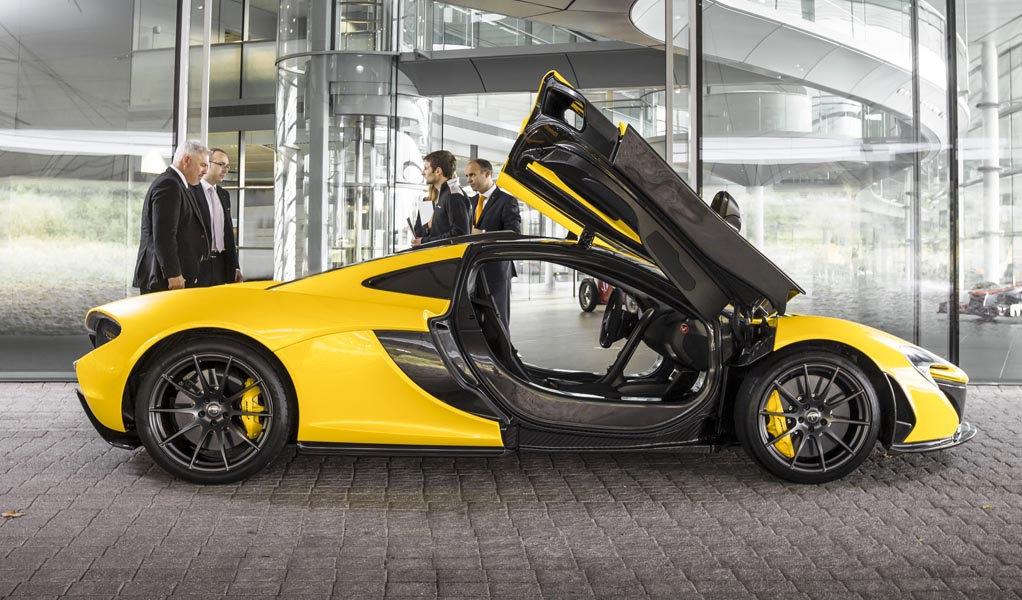
McLaren is an acknowledged world leader in carbon technology. The material offers lightness, strength and rigidity – improving performance, safety, handling, agility, durability, efficiency and ride comfort. The body panels of the McLaren P1™ are also made from lightweight yet strong carbon composite, with their complex shapes tuned for optimal aerodynamics.
The McLaren P1™ was designed from the outset to prioritise aerodynamic performance – just like a Formula 1 car. As with a Formula 1 car, wind tunnel testing and CFD (computational fluid dynamics) aerodynamic modelling were used to optimise the aerodynamic flow, both to provide incredible levels of downforce and to cool the powertrain. The result is 600kg of downforce at well below maximum speed (257 km/h / 161 mph) in Race mode, which is considerably higher than most other high performance supercars, and more in line with the levels of downforce generated by a GT3 racing car. This downforce improves the car’s cornering ability, especially in high speed corners. Balance, agility and controllability are all outstanding.
Other areas of Formula 1 technology evident on the McLaren P1™ include the revolutionary layered carbon ceramic brakes, developed for the road by McLaren’s Formula 1 partners Akebono. The highly efficient IPAS (Instant Power Assist System) is a development of KERS (Kinetic Energy Recovery System) used on Formula 1 cars, while DRS (Drag Reduction System) is also used on the McLaren P1™, giving extra power and straight-line speed both at the touch of a button. Brake Steer – an outlawed Formula 1 technology – is also used on the McLaren P1™. It improves cornering behaviour and cornering speed.
‘The carryover Formula 1 technology on the McLaren P1™ is palpable,’ notes Dick Glover, Research Director. ‘From the aero work, to the carbon fibre MonoCage monocoque and body, to the active suspension [now banned in Formula 1] to the Brake Steer [now banned in Formula 1], to the turbocharging [which comes back into Formula 1 in 2014], to many other engine examples including the low crankshaft and dry sump lubrication.’
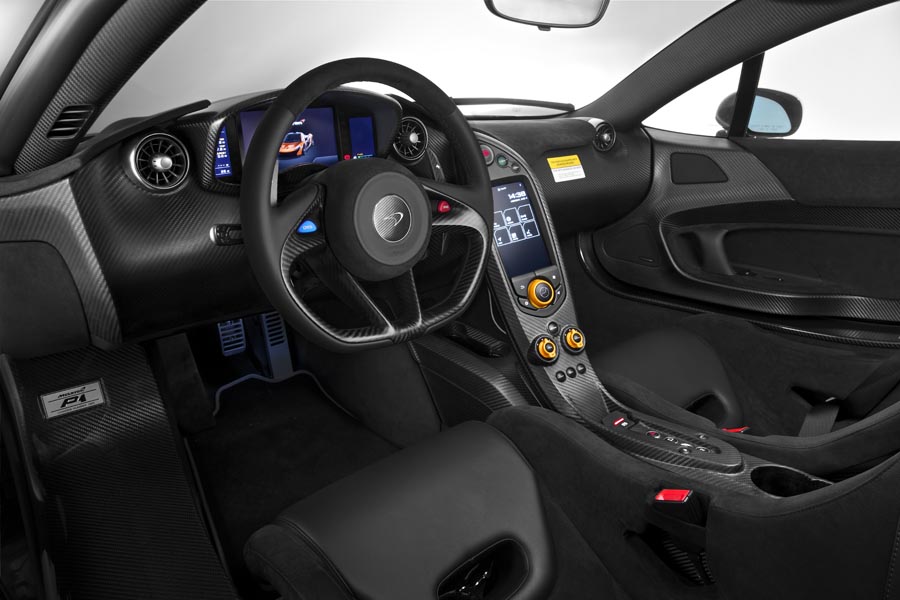
The IPAS petrol-electric powertrain also ties in with upcoming Formula 1 regulations. From next year (2014), Formula 1 cars will have hybrid power, including an electric mode for the pit lane.
The McLaren P1™ name is also inspired by Formula 1. P1 refers to ‘first place’ or ‘position one’ – particularly fitting as McLaren has 182 Grand Prix victories and 155 pole positions to-date, in its 47-year Formula 1 history. There is also heritage in that name: the McLaren F1 was initially known internally within McLaren as Project 1, or P1.
Despite the huge performance, the McLaren P1™ is also a refined and comfortable high-speed supercar. ‘It is designed to be driven to the racing circuit, with great levels of comfort and refinement,’ says McLaren P1™ programme director, Paul Mackenzie. ‘And then to be used on the racing circuit, where it will offer an experience matched only by purpose-built race cars.’
Adds Chief Design Engineer Dan Parry-Williams: ‘It’s fast on the racetrack but still fast, comfortable and refined on the road.
‘The brief was to make a refined, fuel efficient car that is faster than anything else on the racetrack but that is also as fast as anything you could use on the road while not compromising ride or comfort.’
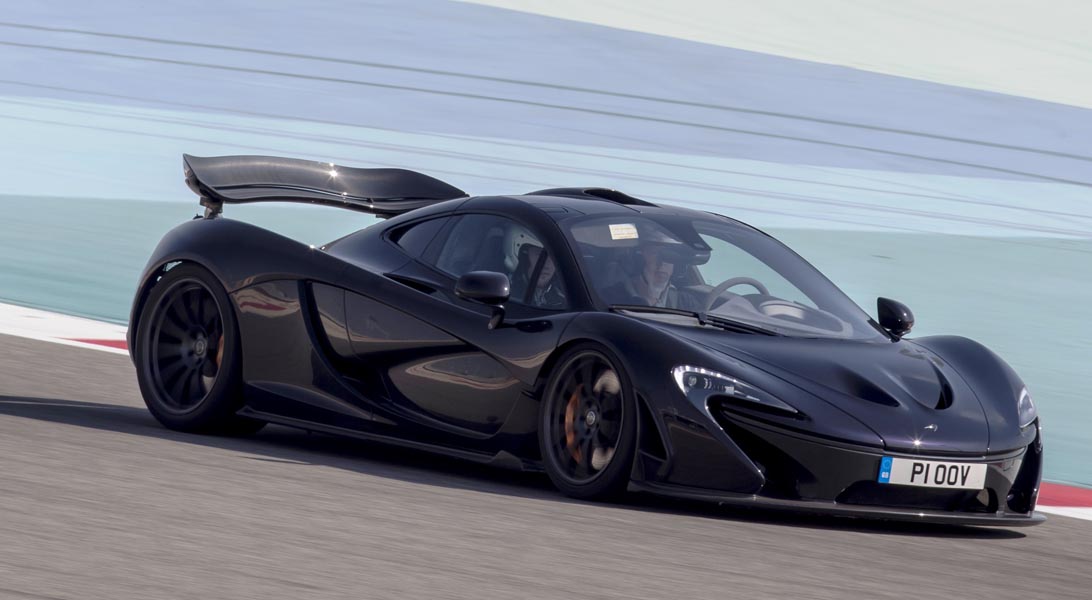
The ownership experience with the McLaren P1™ will be as special as the car itself, Greg Levine, McLaren Automotive Sales and Marketing Director explains: “Owners will become part of the McLaren family, if they aren’t already. To maintain exclusivity, we have closely monitored demand, and announced a production number of just 375 units – a figure that will ensure the McLaren P1™ will remain a rarity and, if spotted on the road, an unforgettable sight.”
DESIGN
The McLaren P1™ is very much an engineering-led design, as is the McLaren way. Form follows function. Nothing is superfluous. Everything is designed for a reason, as with a Formula 1 car.
The mid-engine two-seater design reflects the aerodynamic requirements needed to meet the ambitious downforce target. But there was also clearly a desire to make a very beautiful and striking ‘supersports’ car.

Says Chief Design Engineer Dan Parry-Williams: ‘The McLaren P1™ reflects the brand’s core values. It celebrates aerodynamics, great packaging and light weight, and is all about innovative technology. At the very beginning, we sought to develop a car that you could drive to a racing circuit, then press a button and race it.
‘The priority was high-speed performance matched with tremendous composure, which would come mostly from the state-of-the-art aerodynamics. We wanted a car that was connected and predictable at any speed.’
‘Light and agile’
The design team worked to a brief of ‘light and agile’. The design had to be ‘shrink wrapped’ around the mechanicals, making the car as compact and lightweight as possible. Even the number of body panels – all made from lightweight carbon fibre – was kept to a minimum. The strong carbon construction means they can ‘multi-task’ – acting as aero-honed ducts and load-bearing supports. They are intricately shaped yet superbly finished, helped by their strong carbon construction. There are only five main panels: front clamshell, front bonnet, rear clamshell and the doors.
The McLaren P1™ sits extremely low (1,138mm height in Race mode) with a substantially smaller frontal area than the (already small) 12C, and smaller than any other series production super sports car. Cd is just 0.34 – very low considering the enormous levels of downforce.

Shrink-wrapped design
The incredibly low rear and pronounced rear haunches highlight the ‘shrink wrapped’ design and efficient packaging. Importantly, the design gives superb airflow to the large adjustable rear wing. The shape of the whole body, and the sculpted doors in particular, are clearly shaped by the path of the air flowing over and around the car.
The ‘shrink-wrapped’ design concept, including the low rear deck, rear wing, inlets and outlets, and teardrop-shaped glass canopy was initially produced as a three-dimensional surface model by Chief Design Engineer Parry-Williams, and his team, which defined all of the critical packaging and aerodynamic requirements. This was evolved from current Le Mans car principles. This preliminary surfaces were developed and refined throughout the Concept Design process to create the final styled shape, while still respecting all of the aerodynamic, cooling, packaging and manufacturing requirements. During this phase, details of systems such as the roof snorkel engine air intake, radiator air intake systems, front underbody aerodynamics, ‘low temperature’ cooling system and engine bay cooling were all worked out in detail. This involved extremely intensive detail engineering design, aerodynamic CFD simulation for aero efficiency and cooling.
Parry-Williams explains: “An early mule prototype was built during this phase to prove out the simulation results, while the design was still fluid. Developing the design to this point before the styling process was essential in order to achieve the incredible compactness, aerodynamic performance and overall design integrity.”
Working closely with Parry-Williams, Design Director Frank Stephenson wanted a car that was ‘striking but also functional, a real statement of intent. I wanted a genuinely beautiful and dramatically honest “supersports” car, in keeping with the heritage of McLaren but also at the forefront of automotive design.
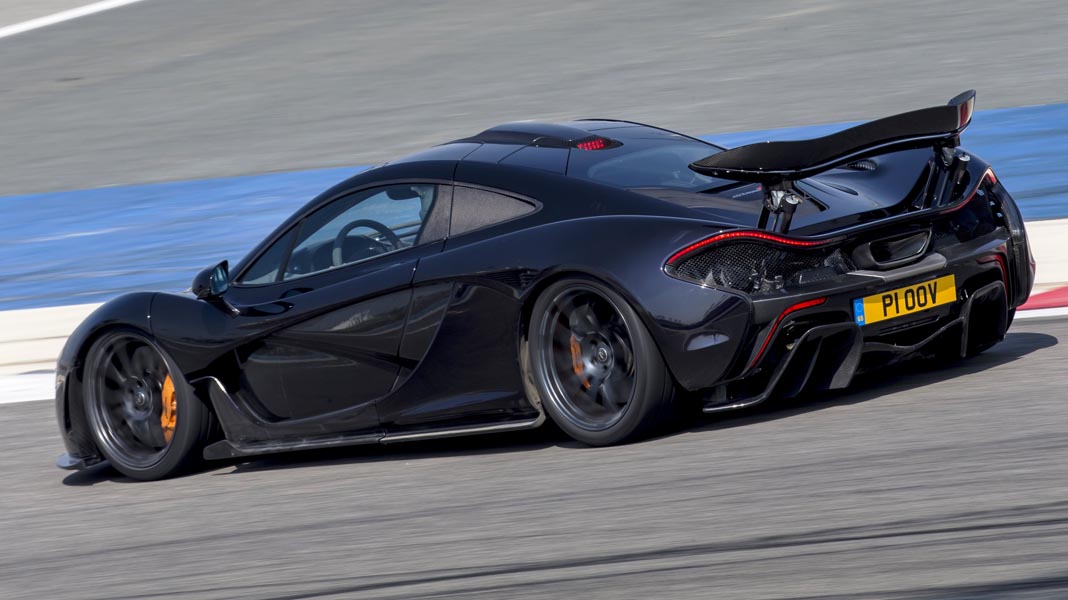
‘The engineering priority was unmatched aerodynamic performance. My role as a designer was to make it look dramatic and beautiful. I wanted it to look like a Le Mans racer with that low body, long rear deck and open mesh rear styling to put the mechanicals on view and to help cooling,’ says Stephenson. ‘Plus there is the most aggressive rear diffuser ever seen on a road car. Like everything on the McLaren P1™, it’s there for a good reason.’
Fighter jet canopy
The glasshouse on the McLaren P1™ was inspired by the canopies of fighter jets, which creates a sense of flying. As with the 12C, the windscreen is deeper than it is wide, which gives a feeling inside of lightness and airiness in the cabin. The front cowl is especially low. Good visibility has always been a McLaren mantra. The two glass solar-reflecting panels above the cockpit further improve visibility and airiness, while the teardrop shaped canopy optimises the airflow to the rear wing.
The ‘hammerhead’ style nose looks dramatic, giving the car a low and wide stance but, as with everything on the car, it also serves an important functional purpose. The design serves to direct airflow to two front mounted low temperature radiators, which cool the petrol engine’s turbocharged air and the IPAS powertrain’s electrical system. The narrow LED headlamps, shaped in the style of the McLaren ‘speed marque’, give superb illumination but are also very space efficient, optimising the frontal area that can be used for cooling.
The distinctive shape of the bonnet vents are entirely dictated by function. These direct the hot air exiting the front radiators, leaving a channel of clean, cold air to feed the roof-mounted engine intake snorkel. The hot air directed over the roof of the car helps to boost downforce, yet it is kept away from the car’s flanks, ensuring fresh air is ingested by the main side-mounted radiators.
At the rear, the LED taillights are invisible by day but offer attractive and ultra thin strips of light by night. They are as thin as possible to maximize the surface area for hot air to escape. This signature rear graphic, which highlights the very edge of the bodywork, was inspired by sports prototype racers, says Stephenson. The rear of the car is entirely open to aid cooling and to extract turbulent air from the rear wheel arches and help aerodynamic flow.

Inspired by the F1 and by Formula 1
Stephenson said he was inspired by two cars from the brand’s history when he and his team designed the McLaren P1™: the iconic McLaren F1 road car of 1993, and Lewis Hamilton’s championship winning 2008 Formula 1 car, the MP4-23. He explains: ‘The 2008 season was the last year they allowed Formula 1 cars to have all the aero appendages. We had the MP4-23 in the studio for about a year, and we studied every element of the car, which was styled for function, not beauty. However, they still made the car look beautiful. The car’s scoops and slats influenced the style of the McLaren P1™. Every duct and every surface does a job, either in aero or cooling.’
The McLaren F1 road car was a vehicle Stephenson tried to ‘recall but not imitate. The greenhouse graphic on the side is similar, especially the rear three quarter window. The dihedral doors are similar, so is the low front cowl and the side swage lines. The roof snorkel is a feature carried over from the F1.’ The snorkel itself forms part of the carbon fibre MonoCage.
The dihedral doors of the McLaren P1™ are instrumental in the car’s astonishing aerodynamic performance. Unlike the 12C, they have two hinges not one. ‘Two small hinges are lighter,’ says Stephenson. ‘The door is also closer to the body when open.’ Their complex shape helps channel clean air to the side mounted radiators, and also cuts the turbulence normally experienced along the side of a car. Their scalloped shapes are all part of Stephenson’s philosophy to ‘push in’ surfaces, and create an almost ‘exoskeleton’ approach.
‘I wanted to take out as much visual weight as possible, to have a car that was really lean; a car with absolutely no fat between the mechanicals and the skin. It’s as though we stuck a tube inside and sucked all the air out, a dramatic honest shape but also a very beautiful one. It was all part of the engineering and design approach to fanatically take out weight.’

The final design
McLaren has been engaging with potential customers actively in the last few months to get their views on the McLaren P1™, about the car’s styling. Their unanimous verdict on the styling was not to change the car presented last September in Paris. So unusually, the McLaren P1™ has translated to production form with very little change. In fact just one, the addition of LTR ducts ahead of each of the front wheels to further aid cooling and optimise downforce.
McLaren has closely monitored demand so as to maintain exclusivity, and announced a production number of just 375 units.
DRIVING INVOLVEMENT
The McLaren P1™ is groundbreaking through the technology and performance that it offers, but it also optimises the emotions felt the driver and, through sensory enhancements, the driver feels like part of the car, and more connected to the road as a result.
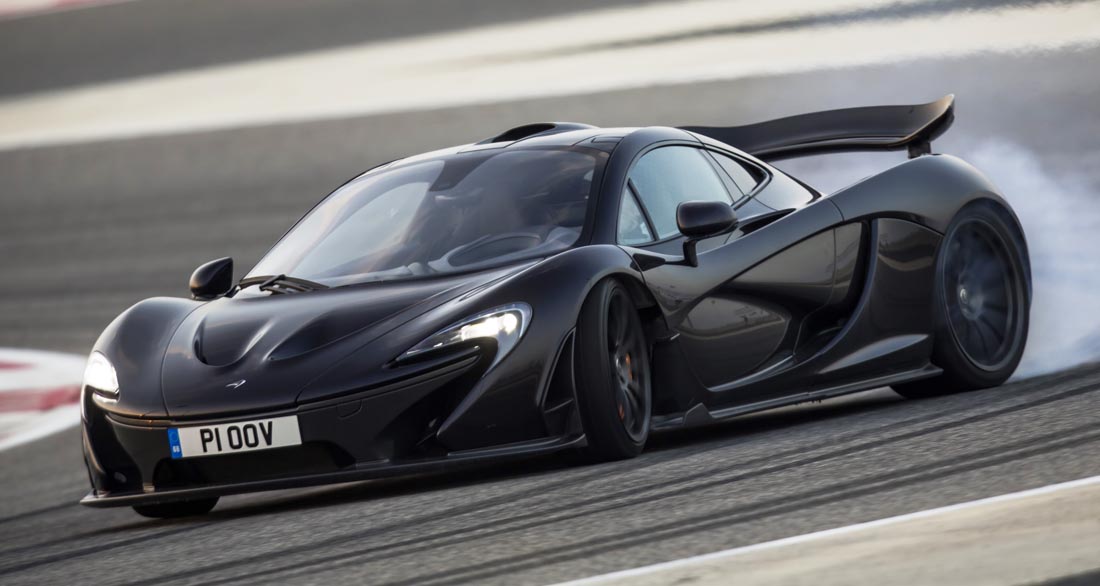
Dan Parry-Williams explains: “When you drive the McLaren P1™, your senses are being stimulated. The primary touchpoints for the driver have been optimised – the steering and pedal feel – to give the greatest level of feedback, and make the driver feel truly connected to what is going on with the car. And this emotional involvement increases as you work through the different modes – E-mode, Normal, Sport, Track and Race – with a real crescendo for the senses in the fully track-focussed Race mode, and you really do feel part of the car.”
Steering
Efforts were made to optimise the steering feel within the McLaren P1™, to ensure that the driver feels directly connected to what is happening. The steering geometry was finely tuned, and the steering ratio has been changed to just 2.2 turns lock-to-lock, compared to 2.6 with the 12C. These changes enhance steering feel and dynamic responsiveness of the car.
Braking
The ‘feel’ through the brake pedal has been refined to give the driver a improved feedback and a greater feeling of connection with the wheels. This enhancement means the braking system is much more progressive, giving a more intuitive brake feel more akin to a racing car, allowing the driver to modulate the brakes more easily.
Throttle
The throttle of the McLaren P1™ is tuned and calibrated to provide the same levels of responsiveness, under very small inputs, in each gear. There are seven individual throttle calibrations, which means that during acceleration and deceleration, a constant rhythm is guaranteed for all gearchanges.
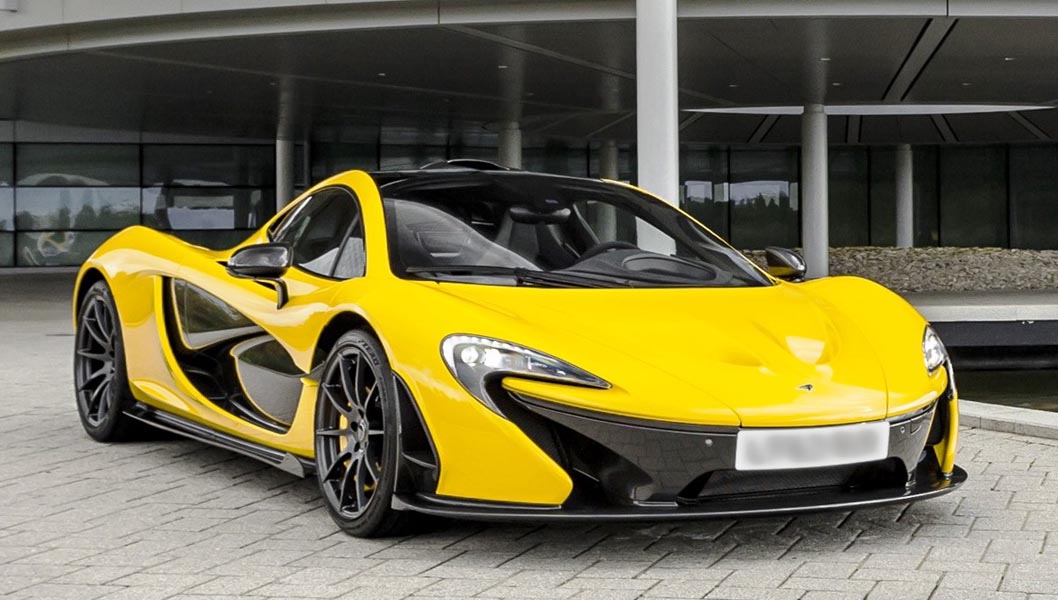
The pedal feel has been calibrated to ensure consistent feel in every gear, both in IPAS drive mode, when the full 916PS (903 bhp) is available through the throttle pedal, and also when the Boost button is pressed so the power from the electric motor becomes available through the steering wheel-mounted IPAS button. This feature gives a consistent, instantaneous throttle response, no matter which mode the car is running in.
Sound
A new device, harnessing the raw exhaust note from the 3.8-litre twin-turbo V8 petrol engine, together with an evolution of the ISG (Intake Sound Generator), and the sounds of the pressure charging system, is clearly audible within the cabin to further optimise the drama of the McLaren P1™. The visceral, exciting engine soundtrack creates an aural experience that instantly matches throttle inputs.
Technical Director for McLaren Automotive Carlo Della Casa explains: “The McLaren P1™ uniqueness is that it is without any filter. The experiences and emotions go straight to the driver, and it is an extraordinary source of satisfaction.”
CONSTRUCTION
McLaren is a global pioneer in carbon fibre technology. It introduced the first carbon Formula 1 car (the MP4/1 in 1981), the world’s first all-carbon bodied road car (the F1, of 1993), and today it makes more carbon road cars than any other manufacturer. Unsurprisingly, as the flagship for McLaren Automotive, the McLaren P1™ has a carbon fibre monocoque, carbon fibre body panels and a carbon fibre interior. It is the perfect material for strength, light weight, rigidity and durability.
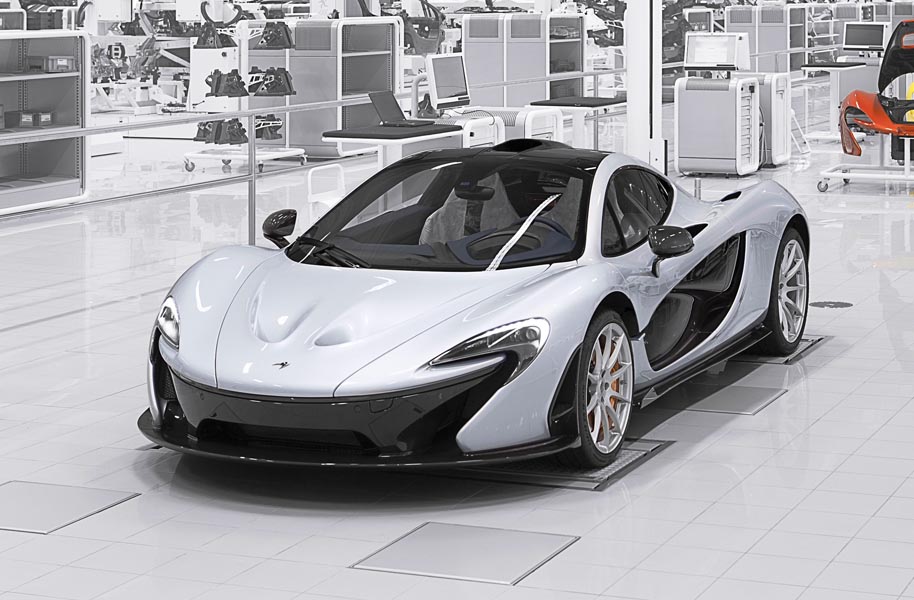
Lightweight MonoCage carbon tub incorporates roof
The entire McLaren P1™ is built around its carbon fibre tub, as with the 12C, which provides a protective cell for occupants and forms a light, yet immensely rigid, structure to which the main components are fixed. On the McLaren P1™, the new carbon fibre MonoCage forms a complete structure, incorporating – unlike the 12C – the vehicle’s roof and distinctive snorkel air intake, The MonoCage also includes the IPAS battery and power electronics, while also meeting full FIA loads and all world crash requirements. Despite these additions, the MonoCage weighs 90kg.
One of the lightest carbon fibre body structures in road cars
At just 90kg, the McLaren P1™ has one of the lightest carbon fibre full-body structures used in any road car to date, and uses the most advanced carbon fibre technology. A combination of Formula 1 style pre-preg autoclave technology and precision resin transfer moulding (RTM) achieves a single piece. Every element of the composite raw material used on the McLaren P1™ MonoCage, and the carbon body, is bespoke. They are tailor engineered specifically to suit the extreme performance and lightness requirements of the McLaren P1™, and the uniqueness of the manufacturing technology. They cannot be found anywhere else but McLaren.
The Formula 1-style carbon includes fibres with stiffness modulus as high as 5000 GPa (more than twice the stiffness of steel), fibres with strength greater than 6000 MPa (more than five times the strength of the best grade titanium), and includes the use of Kevlar fibres.
This high-technology tub gives numerous dynamic benefits. Occupant safety is improved, the light weight improves performance and reduces emissions, agility is improved, and the high torsional rigidity ensures accurate suspension geometry, boosting ride and handling.
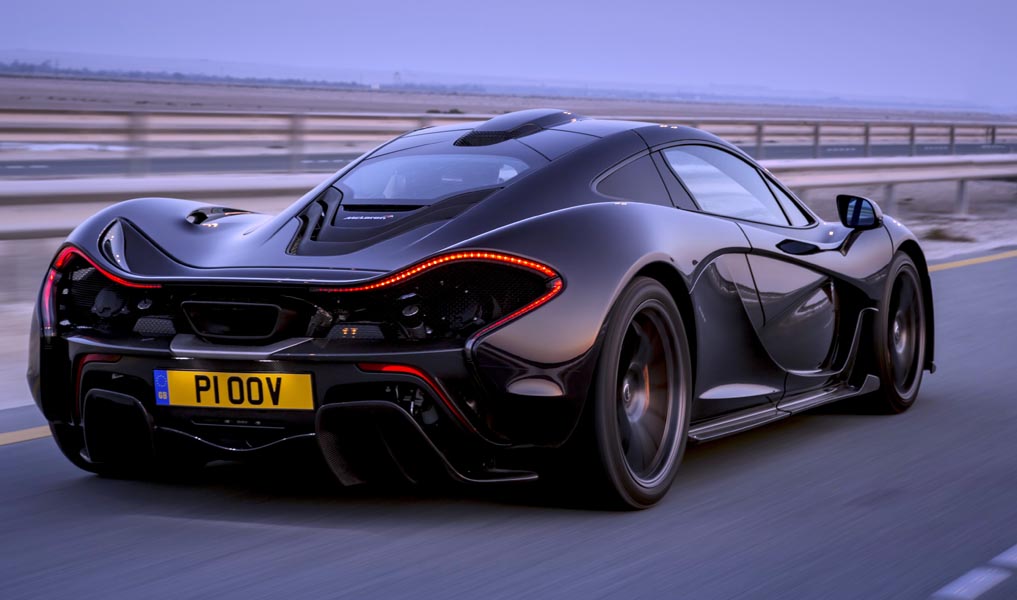
Pre-preg Formula 1-style carbon was specified for all body panels. The panels incorporate carefully designed cooling ducts and aero surfacing, they need to be light but strong. ‘One moulding has been designed to do as many jobs as possible,’ says Chief Design Engineer Dan Parry-Williams. ‘We followed the old Colin Chapman diktat that “nothing is as light as nothing”. Unnecessary components were removed. If you can create mouldings that do as many jobs as possible, you have fewer parts and less weight. I also hate brackets and nuts and bolts. We ruthlessly removed them when at all possible.’
This meant the carbon mouldings were more complex in shape, and more expensive and time-consuming to design and build.
Strong yet very light carbon body panels
The front and rear clamshells are large single piece mouldings, which are strong yet incredibly light. ‘You can pick them up with two fingers,’ notes Parry-Williams.
The front clamshell includes the moulded luggage bin, which offers 120 litres of storage. The rear clamshell is fixed; it only comes off during servicing. Two service flaps, just behind the roof, give access to fuel filler, oil High Power Density (HPD) battery charger socket and coolant. The wheel arch liners – also made from pre-preg carbon fibre – double as air intake ducts and mountings for the HPD, the IPAS battery, charge air coolers and oil coolers and the clutch.
Inside the cabin, there is no floor carpet – it is unnecessarily heavy – and no sound deadening. Even the glass has been re-engineered to reduce weight. The super lightweight glass used in the roof has been chemically toughened, and is only 2.4mm thick. The windscreen is only 3.2mm thick, including a plastic interlayer, and compared to the 12C’s 4.2mm screen, this saves 3.5kg.

POWERTRAIN
The McLaren P1™ needed a powerful yet highly fuel-efficient powertrain that offered superb throttle response. ‘These were essential qualities for the world’s best driver’s car,’ says Dan Parry-Williams.
High levels of power were crucial for the car to deliver the performance requirement: to be faster, around a racing circuit, than any other production road car. Sharp throttle response is a key requirement of any great driver’s car. Fuel efficiency has always been a McLaren mantra – great efficiency is the hallmark of quality engineering.
‘The best all-round solution, we quickly deduced, would be a petrol-electric engine,’ says Parry-Williams. ‘It gives us very high levels of power, instant torque and terrific fuel and CO2 figures. The result is a powertrain that feels like a very strong, normally aspirated engine.’
The twin-turbo petrol V8 and single electric motor – both mounted behind the cockpit in a mid-engine position – have a combined output of 916PS (900 hp) and 900Nm, with emissions of less than 200g/km. Power is driven to the rear wheels through a seven-speed dual clutch gearbox.
The car can be driven in a variety of modes, powered solely by the electric motor, or using a combination of the two.
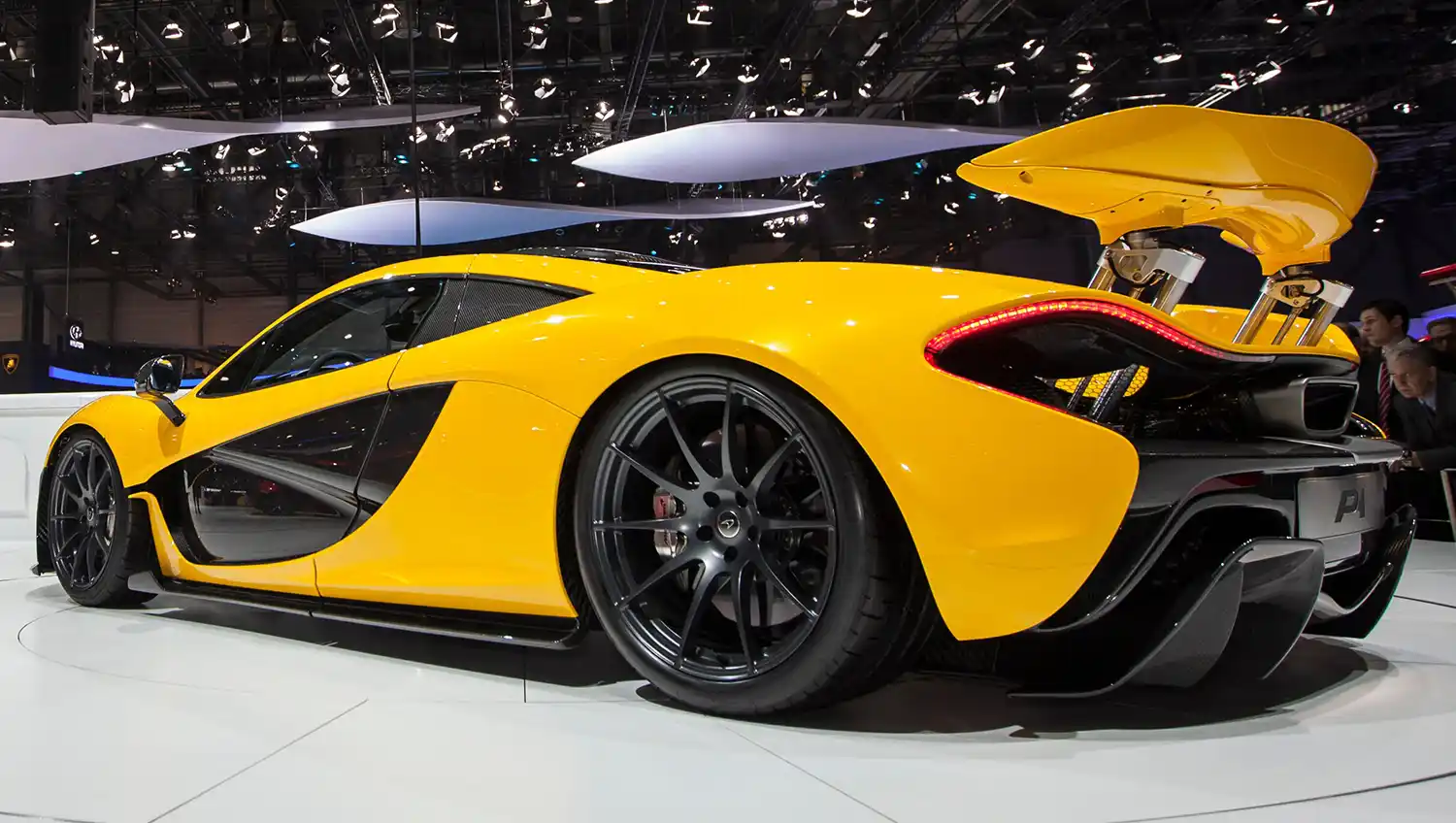
Maximum power comes when using both engines together, but even in E-mode the performance is strong. ‘It’s pretty cool to turn up, silently, in a million dollar McLaren,’ notes Paul Mackenzie, Project Director on the McLaren P1™.
In IPAS (Instant Power Assist System) mode, the battery is recharged using surplus energy from the petrol engine – when decelerating, for example. It can also be plugged in to recharge the battery.
IPAS, developed by McLaren, can provide up to 179PS (176 bhp) from the electric motor, and can be deployed at the touch of the steering wheel-mounted button.
Petrol engine
The 3.8-litre twin-turbo V8 petrol engine in the McLaren P1™ is a new version of the M838T unit, called M838TQ. It is fitted with an all new pressure charging system to optimise cooling and durability under the higher loads. The engine block has a unique casting, to incorporate the electric motor and also to provide increased stiffness.
The turbochargers are new and run at 2.4 bar (compared to the 12C which runs at 2.2 bar), while the compressor and turbine housing are bespoke to McLaren. As with the 12C and 12C Spider, the turbos are water-cooled and oil lubricated.
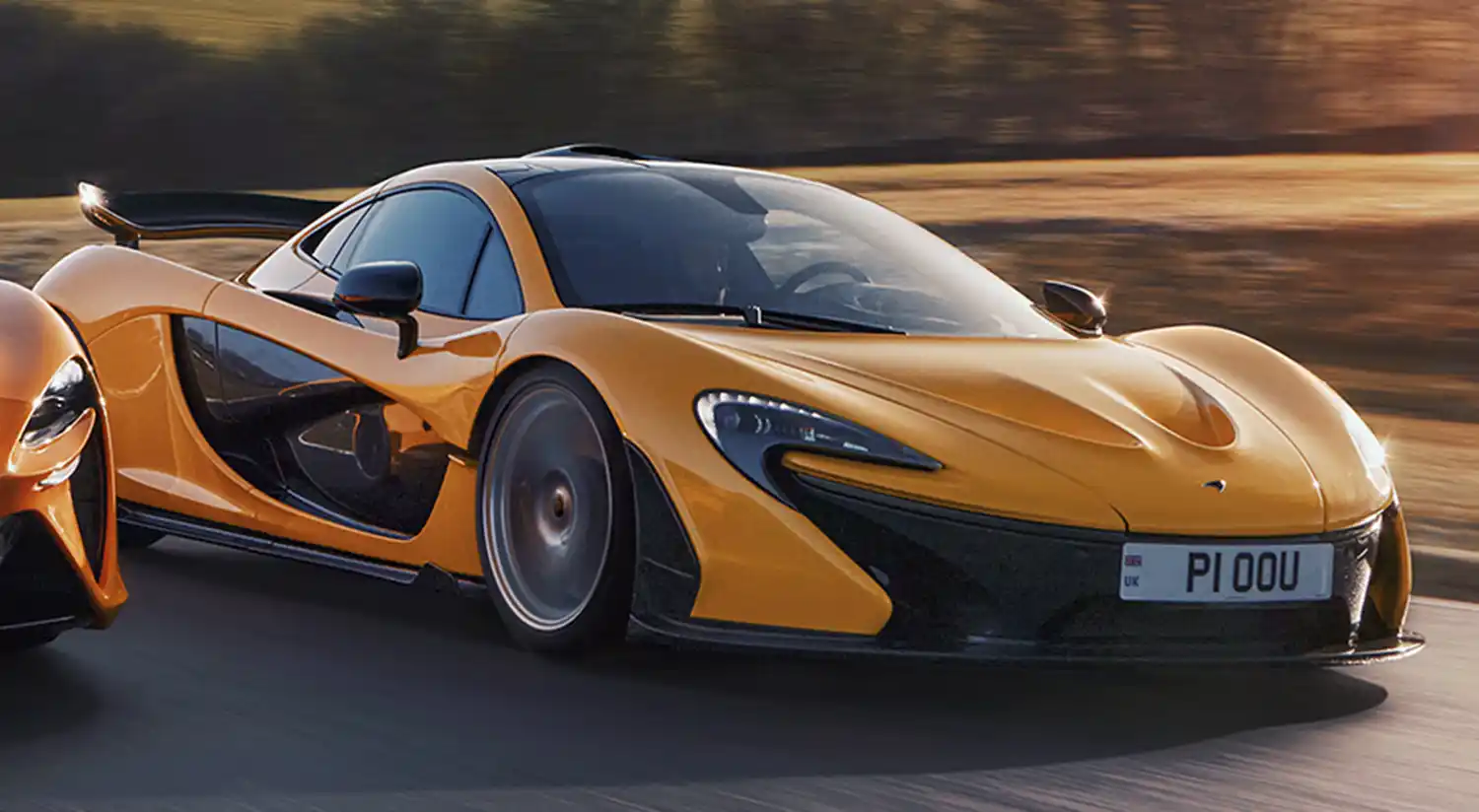
The petrol engine on its own produces 737PS (727 bhp) at 7500rpm, and 720Nm of torque from 4000rpm. Naturally, the engine has dry sump lubrication, as on a Formula 1 car, and a low sited flat plane crankshaft – to lower the centre of gravity.
Electric motor and instantaneous torque from IPAS
The single electric motor produces 179PS (176 bhp) and 130Nm of torque – although, as it’s geared by a multiple of two, it has an effective torque output of 260Nm. It has been developed by the McLaren Electronics arm of the Group, and is unique to the McLaren P1™. Like all electric motors, it can produce maximum torque instantly, greatly increasing the throttle response of the McLaren P1™.
‘It helps give extra torque anytime, anywhere, and comes in instantly,’ notes Chief Test Driver Chris Goodwin. ‘It makes a huge difference and fills in the holes in the torque curve that you often get with turbo engines.’
As the electric motor sharpens throttle response, so bigger turbochargers – which traditionally inhibit throttle response – can be used to boost overall power. The electric motor and 3.8-litre twin-turbo V8 petrol engine thus work seamlessly together, serving up both instant throttle response and very high maximum power.
The electric motor has internal rotor cooling – unusual for an automotive electric motor – which enables the engine to produce maximum performance for longer periods, and an outer jacket is also used to further aid cooling of the electric motor.

The electric motor on the McLaren P1™ weighs 26kg, and produces more than double the power of the KERS unit used in Formula 1 (179PS versus 82PS). The additional power from the electric motor can be deployed through the IPAS button mounted on the steering wheel.
Battery
The ground-breaking, lightweight battery pack used in the McLaren P1™, offers greater continuous power density than any other car battery pack on sale today. McLaren has prioritised power delivery over energy storage, and so the system is designed to deliver power rapidly for high performance acceleration. The battery is capable of providing instant additional power, which is accessible through pressing the steering wheel-mounted IPAS button. This set-up can provide up to 179PS (176 bhp) and an electric range of over 10 kilometres on the combined European drive cycle.
Energy, which would normally be wasted, is captured by the electric motor when lifting off the throttle, and harvested in the battery, especially in higher gears. The decision was taken to maintain a consistent feel during braking – crucial for performance driving – and for this reason, direct braking kinetic energy regeneration is not employed. ‘The priority is the driving experience,’ notes Dan Parry-Williams.
In addition to the battery being charged via the engine, the McLaren P1™ is also equipped with a plug-in charger which can recharge the battery, from empty, in as little as two hours. The plug-in charger can be stored in the luggage compartment, although the customer may choose to store it off-board – in a garage or the pits – to save weight.

A fast ‘pit lane charging’ function means the battery can be ‘quick charged’ in only 10 minutes, if needed, which provides a complete, 100 per cent charge. The ‘Charge’ button on the fascia allows the driver to recharge the battery quickly, using the V8 engine as a generator, in preparation for electric-only use (to extend range) or for a hot lap (where maximum additional electric power can be utilised).
The high power density has been achieved through a combination of ultra high power cells, low pack weight and an innovative cooling system. The battery weighs just 96kg, and this is crucial in optimising the performance of the McLaren P1™. It is mounted between the cabin and engine bay for best weight distribution, within the high-strength Formula 1-grade carbon fibre MonoCage chassis. This seals the unit in the vehicle, thus avoiding the added weight of any unnecessary battery packaging.
The battery itself uses six modules, each of 54 cells (324 cells in total), and uses a Battery Management System (BMS) with active cell balancing, which is able to transfer charge from cell to cell to maintain accurate balance throughout the power pack, thus ensuring optimum performance and durability. Due to the amount of power being supplied by the battery, complex cooling is required to guarantee cell performance and reliability. The coolant flow is balanced to ensure each cell is cooled to the same temperature across the entire pack. Two extremely accurate and fast safety-critical monitoring boards are fitted to each cell module, reporting on battery cooling, state of charge and battery health.
Transmission
The electric motor is integrated into the 3.8-litre twin-turbo V8 petrol engine, and drives a dual-clutch seven-speed gearbox. All drive – either in electric or IPAS mode – goes through the gearbox. As the electric motor can be decoupled from the petrol motor, so the car has, in effect, three clutches.
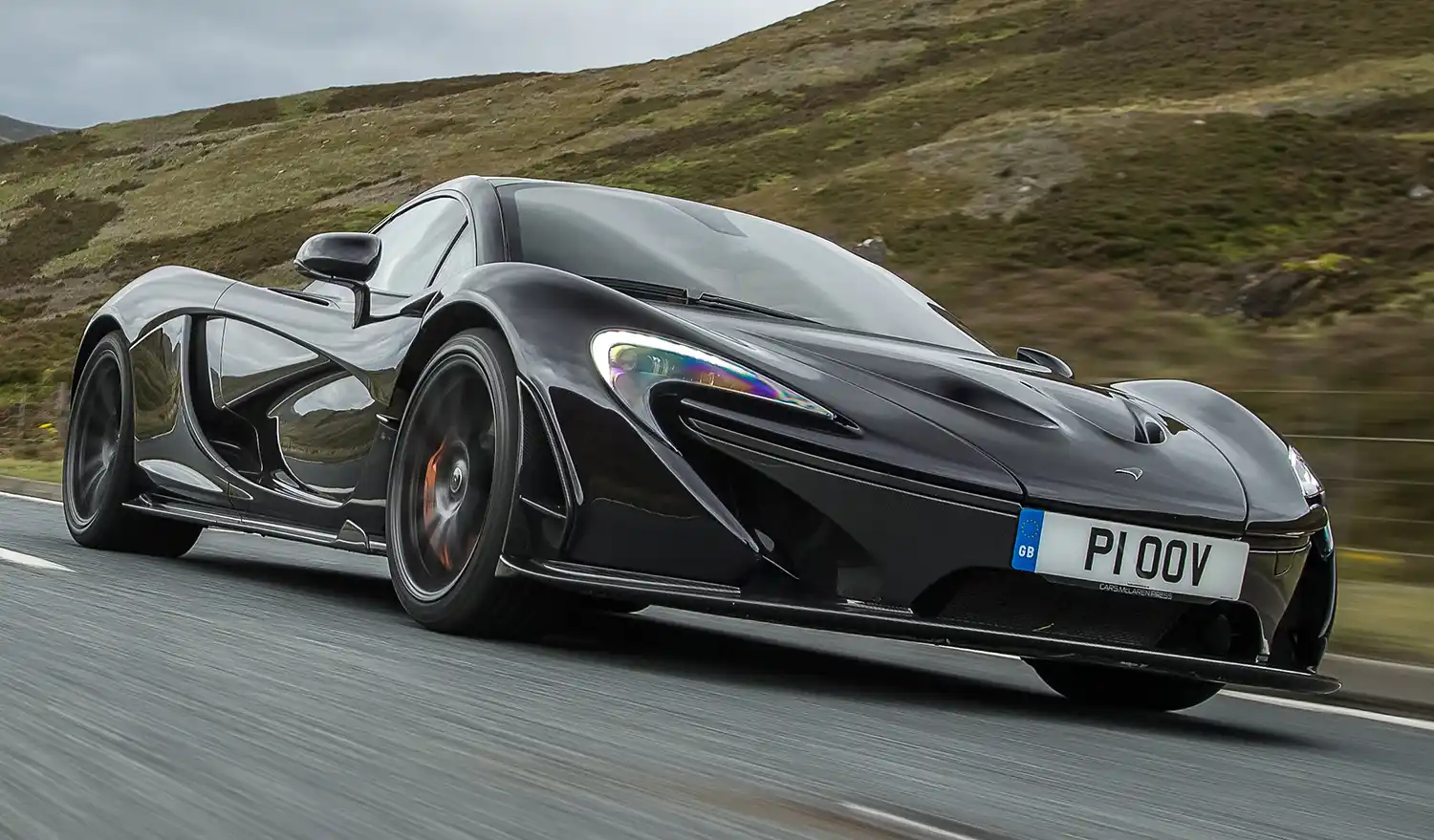
The gearbox is an uprated version of the unit found in the 12C, but additional cooling is required to manage the more powerful IPAS petrol-electric powertrain. Two air-blast clutch coolers are also fitted to optimise oil cooling.
Manual gear-shifting is by paddles mounted on a rocker behind the steering wheel: to upshift pull with the right fingers or push with the left, and vice versa to downshift. The paddles are made from carbon fibre and optimised for weight-saving. They have also been ergonomically designed to allow ease of use whilst also operating the IPAS and DRS buttons.
The default for the McLaren P1™ is a fully-automatic mode, which is especially useful for city driving. The paddles can also be used while in automatic mode, and a fully manual gearchange can be selected via a button on the Active panel. In E-mode, the McLaren P1™ always drives in automatic.
E-mode
The E-mode is the most economical mode available with zero tailpipe emissions and almost silent running. Where possible, the car will drive in electric-only power, but should there be insufficient battery power, the petrol engine will automatically start. The car is also eligible to drive in towns or cities that may restrict or ban internal combustion engine vehicles.

In E-mode, the McLaren P1™ can travel more than 10km – enough for most city journeys – and at speeds of over 160km/h. When the battery is empty, the petrol engine will automatically start to maintain drive and charge the battery. Performance remains the same as in electric-only drive. This is achieved through an ECU map restricting performance to the equivalent of the electric motor.
E-mode is selected before setting off via the E-mode switch on the dashboard prior to switching on the ignition. If already on the move, the powertrain will then instantly change to electric power when the E-mode button is pressed.
By pushing the Charge button (next to the E-mode button), the petrol engine will quickly recharge the battery. When the battery is fully recharged, in E-mode the petrol engine will stop automatically. Recharging the battery in this way takes only 10 minutes.
In E-mode, the twin clutch seven-speed gearbox will change gear automatically. Operating the paddles will have no effect. The handling settings are the same as the Normal suspension mode. It is not possible to select other handling settings.
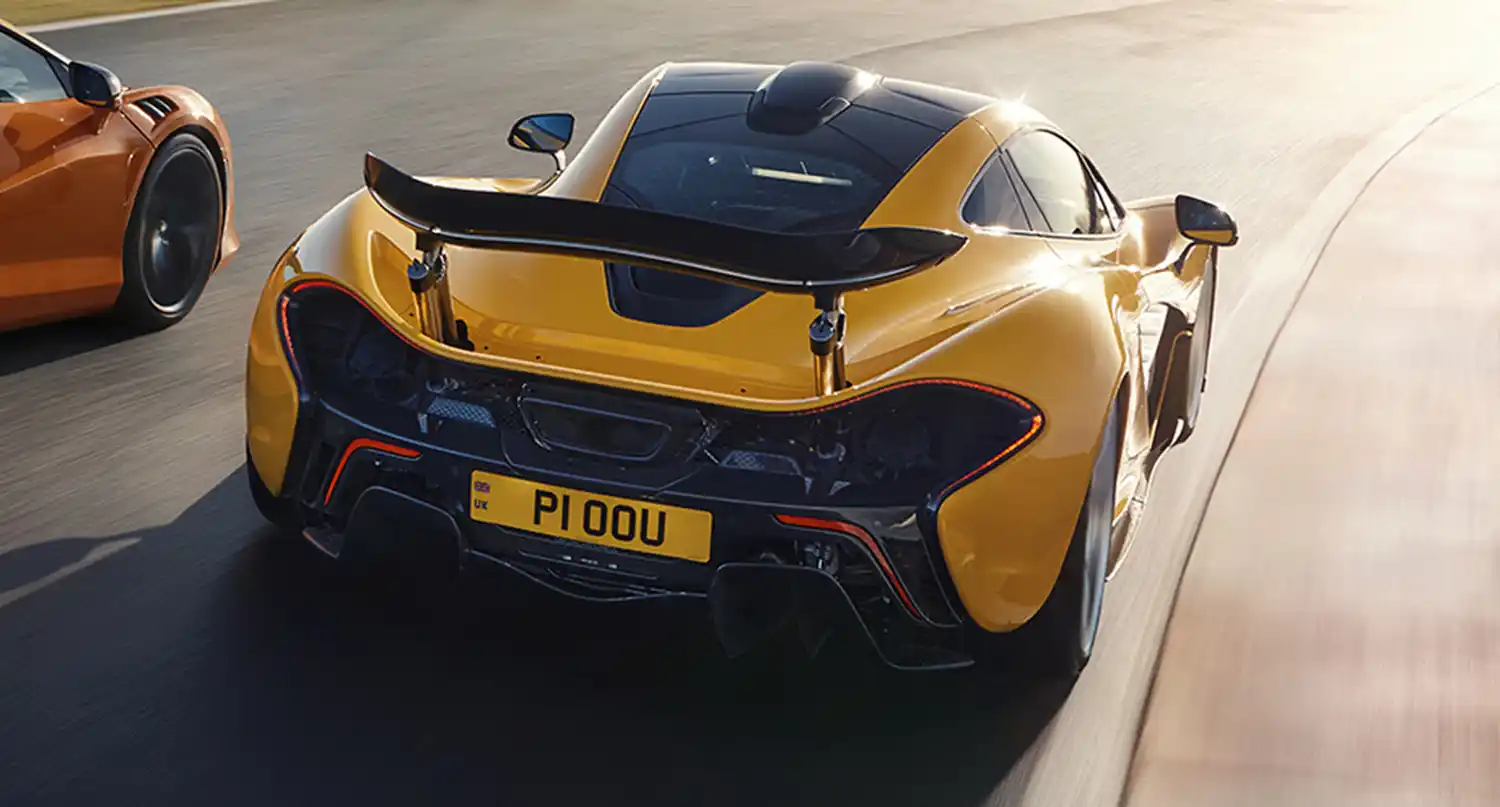
IPAS petrol-electric mode
The default mode for the McLaren P1™ is in IPAS drive, when both petrol and electric motors combine. Together, combined power is 916PS (903 bhp) and torque is 900Nm – although this is limited to protect the clutch.
The electric motor does far more than just add extra ultimate power and torque. The instant response of the electric motor provides sharper throttle response that is normally associated with a normally aspirated motor. This is especially beneficial when mated to a petrol engine using large turbochargers. ‘It’s particularly useful just after gear shifts to “fill in” the torque gap when the turbos are responding,’ says Chief Test Driver Chris Goodwin. A further benefit is that the electric motor can provide faster upshifts. This is achieved by the electric motor providing negative torque, which makes the engine revs drop as quickly and efficiently as possible to the required engine speed for the upshift.
The use of an electric motor, and an all new pressure charging system, enables the McLaren P1™ both to have sharper throttle response and more top-end power – the perfect combination for high performance.
Unlike many other powertrains that use both petrol and electric power, the petrol motor on the McLaren P1™ is always active – unless it’s in E mode. It will not continuously cycle between drive modes. ‘We didn’t even try to do it,’ says Dan Parry-Williams. ‘We felt that it would detract from the driving experience to have more unexpected engine starts than absolutely necessary. Believe me, you’d notice if a 737PS petrol engine suddenly starts up behind you.’ At standstill, such as at traffic lights or a junction, the petrol engine will switch off automatically when the brake pedal is depressed, and restart again when released.
IPAS drive operates in Normal, Sport, Track and Race modes.
In addition, the McLaren P1™ has a separate button marked Boost located on the centre console, which diverts up to 179PS (176 bhp) of power and 230Nm of torque from the electric motor through the steering wheel-mounted IPAS button. The system operates only when close to full throttle.
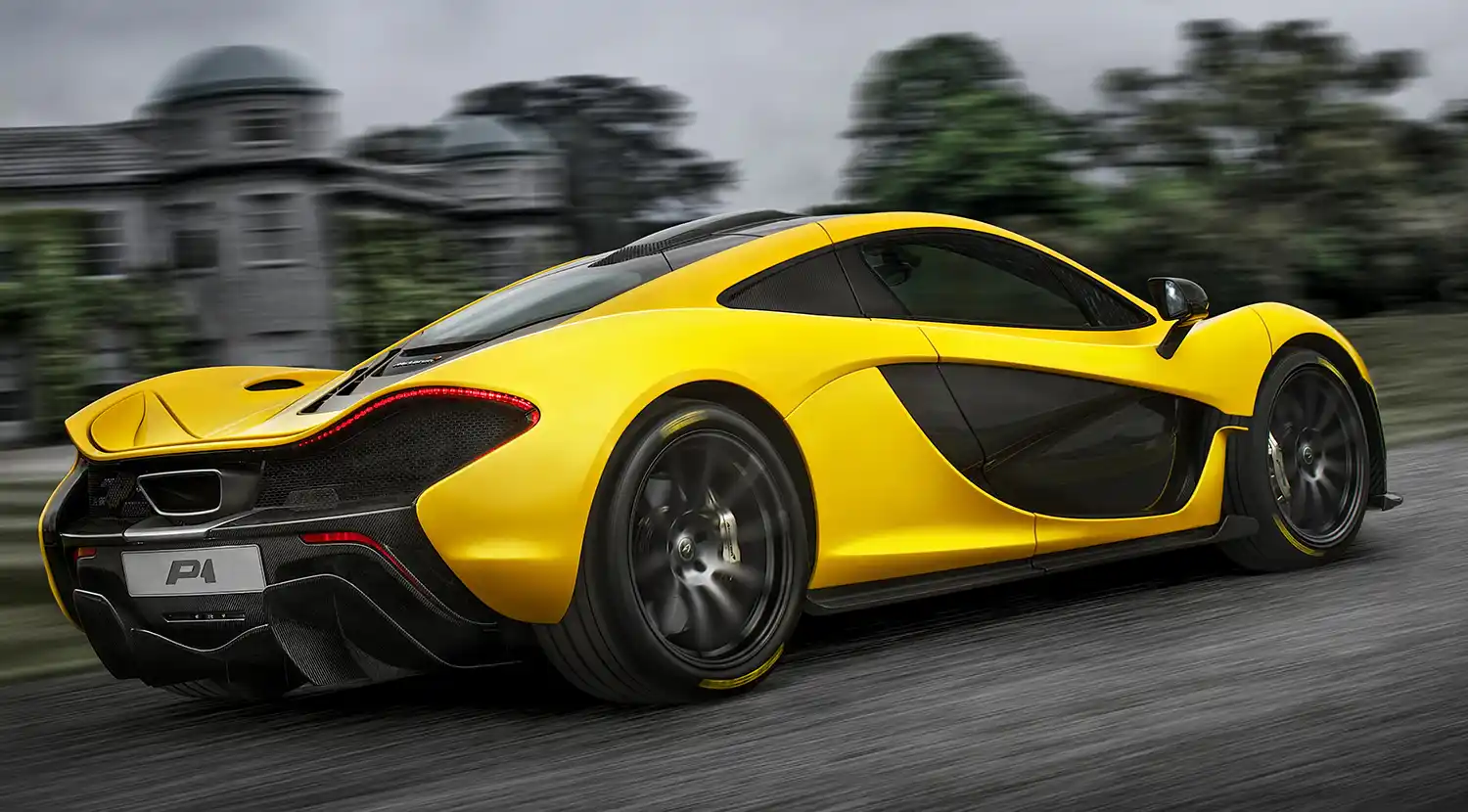
The IPAS button provides additional instant power when Boost is on and, when pressed, deploys the full power and torque available. Unlike Formula 1, there is no time limit to IPAS being deployed in a single press. The total amount of extra power and torque depends on the battery’s state of charge (SOC) and its operating temperature. IPAS can be deployed in all powertrain settings.
There is also a Launch mode, for maximum standing start acceleration. This can be operated in all powertrain modes, apart from E-mode. ESC (Electronic Stability Control) can be deactivated in either Track or Race mode. With the DRS button depressed, the wing remains stowed to minimise drag.
The McLaren P1™ is also fitted with a vehicle lift system, which raises the height of the vehicle 30mm front and rear. This increases the approach and departure angles, and ground clearance is optimised to aid manoeuvrability over ramps and uneven surfaces. The system will remain in the raised state at speeds of up to 60 km/h. If this speed is exceeded, the vehicle will return to its normal ride height.
Performance of the McLaren P1™ is, unsurprisingly, astonishing. Top speed is electronically limited to 350 km/h, while standing start acceleration figures are even more amazing: 0-100km/h in less than three seconds, 0-200km/h in less than seven seconds and 0-300km/h in less than 17 seconds. By comparison, the McLaren F1 road car did 0-100km/h in 3.2 seconds, 0-200km/h in 9.4 seconds and 0-300km/h in 22 seconds.
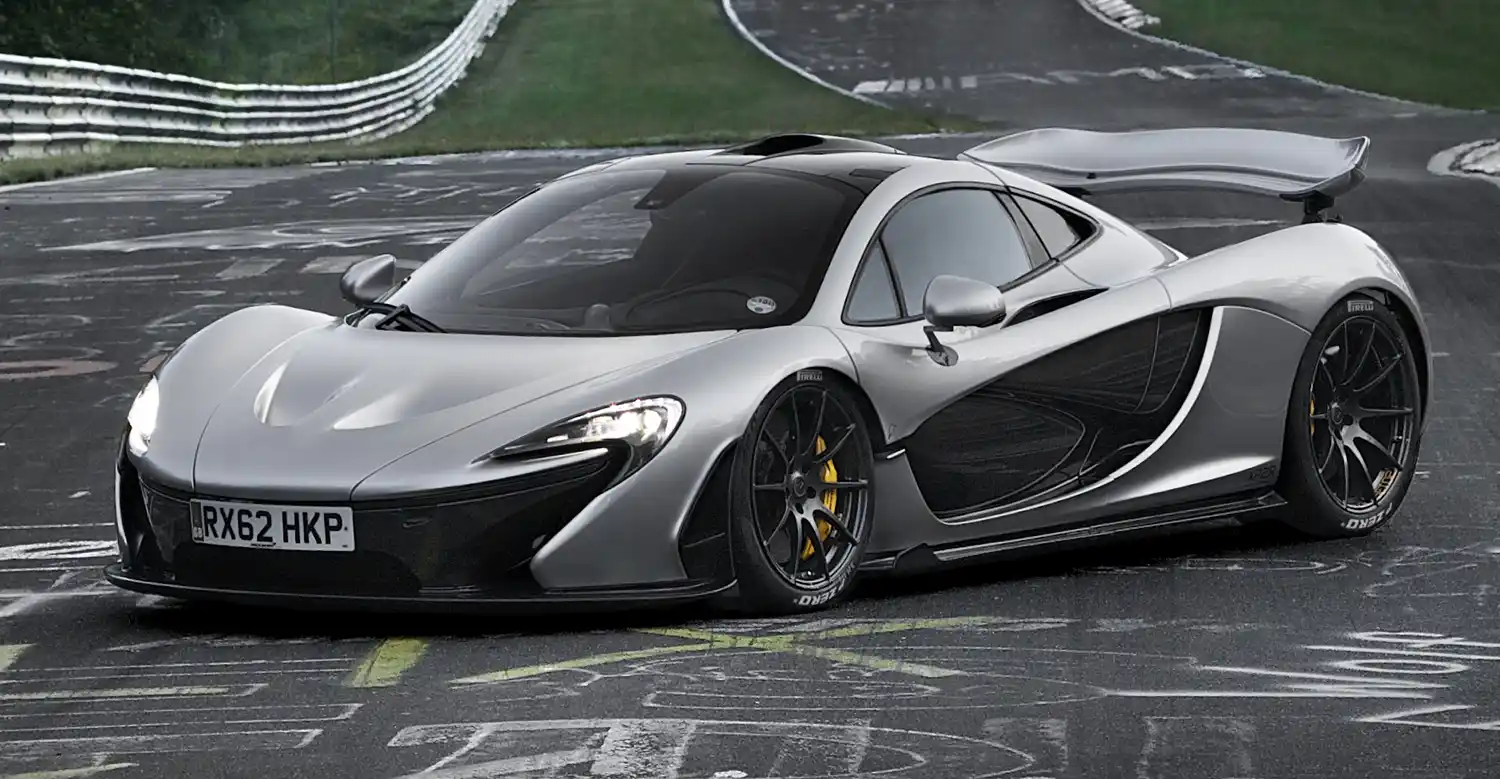
Active mode
When the Active panel is not switched on, powertrain and handling are both automatically set to the default Normal mode, and the car changes gear automatically. Pushing the Active button empowers the suite of high performance controls – including Sport and Track suspension and powertrain settings (activated by rotary switches beneath the Active button), IPAS and DRS (activated by steering wheel-mounted buttons), Launch mode (a button on the dash), manual gear change (push the Manual button) and the active aero and suspension settings. The Active button must also be on before the Race mode can be engaged.
When Race mode is selected, the car automatically lowers by 50mm, and stiffens the suspension through the use of hydraulic springs. This mode gives bespoke roll and damper settings, and spring rates increase by up to 300 per cent.
Exhaust
The Formula 1-style Inconel exhaust system is designed to be light and has been designed so that it follows the most direct route from the engine out to the back of the car, minimising weight. At 17kg in total, it is five kg lighter than the already light 12C system.
The rear of the chassis was engineered to optimise the route taken by the exhaust pipe, to follow the shortest course possible. By taking this action and keeping the exhaust low, the design team were able to keep the rear of the car extremely low. The angle of the exhaust exit has been optimised to match the angle of the rear of the car, helping to create downforce. Exhaust gases exit under the rear wing creating an area of low pressure.

AERODYNAMICS
The McLaren P1™ was designed from the outset in a wind tunnel and using CFD (computational fluid dynamics) aerodynamic tools - just like a Formula 1 car. McLaren Racing’s former head of Formula 1 aerodynamics, and now head of vehicle technology, Simon Lacey, was responsible for its aero performance.
This optimal level of aerodynamic performance produces incredible levels downforce – up to 600kg, which is more than any other production road car to date. ‘The levels of downforce produced actually makes driving easier as well as faster,’ says Lacey. ‘As you build your speed, you actually feel you have greater control as the levels of downforce increase the car’s grip on the track.
‘Every panel, air intake, and air exhaust was designed to guide clean air into the ducts from the most efficient places and to maximise cooling,’ says Lacey. ‘That’s partly why the body is so compact, and looks so “shrink wrapped”. The unusual door ducts draw air into the cooling circuit, the low body helps air get to the rear wing as quickly and effectively as possible, and the rear deck is extraordinarily low, just like a sports racing car. The extreme teardrop shape of the glasshouse guides more air more efficiently to the rear wing.’
The 600kg of downforce is achieved in Race mode, when the car sits at its lowest ride height and has its rear wing fully extended. However that level of downforce is achieved at 257 km/h – well below maximum speed (of 350 km/h). This was a deliberate decision to optimise downforce for ‘real world’ track corners. ‘There is little point in having maximum downforce at V max as you’re unlikely to find a corner that can be taken at V max,’ says Chief Test Driver Chris Goodwin.

The downside of so much downforce at 257 km/h is that, if the aerodynamics were fixed – rather than actively adjustable – the downforce would be so great at maximum speed that the suspension would have to be reinforced. This would add weight for no benefit in track performance. This problem is overcome through the use of active aerodynamics. The McLaren P1™ trims its front and rear wings to spill downforce as the speed increases over 257 km/h ensuring optimum performance.
Active aerodynamics – adjustable front and rear wings
The large rear wing sits flush with the rear bodywork when stowed, but adjusts automatically to boost downforce and optimise aerodynamics. It can extend by 120mm on the road and, when Race mode is activated through the button on the fascia, by 300mm on a racetrack.
When deployed, the pitch of the wing also changes to optimise the levels of downforce, increasing by up to 29 degrees. The double element rear wing profile has been developed using exactly the same methods and software as the Vodafone McLaren Mercedes MP4-28 Formula 1 car. The rear wing can provide a similar function to the Airbrake seen on the 12C and 12C Spider, but it is actually still working like an inverted aeroplane wing. The wing produces significantly higher levels of downforce on the rear of the car than the Airbrake system, ensuring the rear brakes work much more effectively. With the McLaren P1™ in Race mode, under braking, the rear wing can offer up to three times the level of downforce generated by an Airbrake.
In addition to the adjustable ‘active’ rear wing, the aerodynamic performance of the McLaren P1™ is optimised using two flaps mounted under the body ahead of the front wheels. These are also actively controlled, and change angle automatically to optimise performance, optimising downforce and aero efficiency, increasing both speed and grip. The flaps operate through a range of 0-60 degrees.

The rear wing and front flaps work in conjunction with each other to maximise handling, braking and straight-line performance. The active aerodynamics ensures totally consistent handling and driving behaviour.
Ground effect suction
The underbody of the McLaren P1™ is smooth and, as with the body panels and MonoCage chassis, made from carbon fibre. This flat surface beneath the car also helps to generate ‘ground effects’ suction, boosting downforce.
‘On a track, the McLaren P1™ would display similar levels of performance to a Le Mans sports racer, thanks to its aerodynamic shape,’ adds Simon Lacey. ‘It would have a level of racetrack performance never before seen in a series production road car.’
Every design detail optimises aerodynamics, from the door shape, which is designed to funnel air with maximum aero efficiency, to the numerous ducts, to the wheel-arch shapes to the snorkel intake on the roof. The latter detail also ties in with Grand Prix design, and was an iconic feature of the seminal McLaren F1 road car.
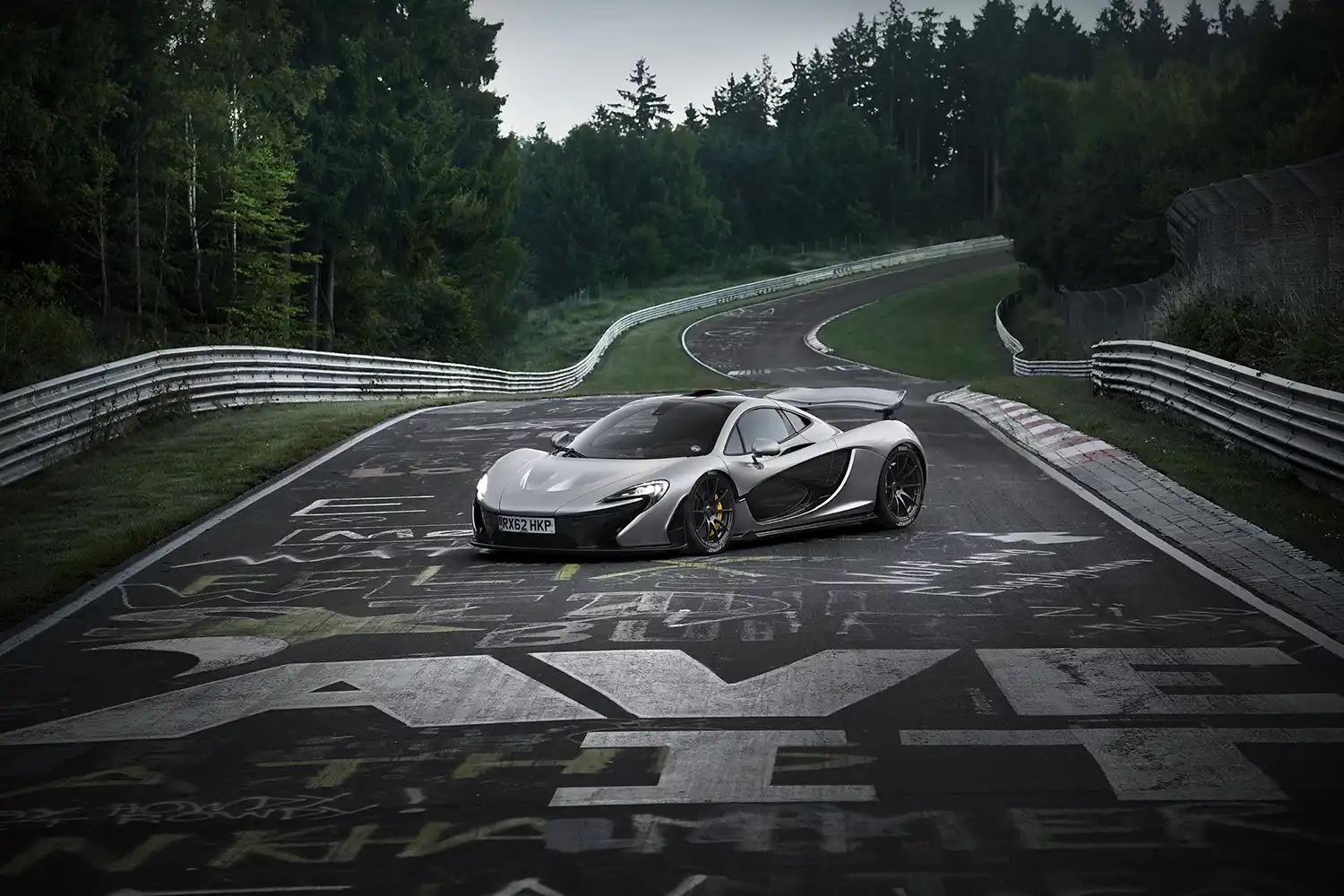
The variable ride height suspension lowers the car by 50mm in Race mode. This ‘squeezes’ the air flowing beneath the body, creating ground effect suction, planting the car to the road at higher speeds.
The aero performance, says Chief Test Driver Chris Goodwin, puts the McLaren P1™ ‘in a different league from anything else. ‘Having raced Le Mans cars, I have a good handle on what they’re like, and we’re up there in that ballpark with this car. In fact, in some ways we’re better because we have more technical freedom. They have aerodynamic and suspension restrictions to adhere to, which we don’t have to work to with a road car.
‘The astonishing thing about the McLaren P1™ is that it feels like a really fast super sports car on the road – really fast – but it feels like a really good racing sports car on the track. I don’t think that’s ever been done before.’
Rear wing with DRS
DRS, or Drag Reduction System, is used in Formula 1 to offer increased straight-line speed, and it is also used on the McLaren P1™. Speed is increased by reducing the amount of drag on the rear wing, and while a Formula 1 car achieves this with a moveable flap on the rear wing, on the McLaren P1™, DRS reduces the angle of the rear wing to zero.

The DRS function is operated by a button on the steering wheel, and takes approximately half a second to flatten the angle of the rear wing. With DRS enabled, the level of drag is reduced by 23 per cent. The system immediately deactivates when the button is released, if the driver touches the brake pedal, or if steering input is detetcted.
CHASSIS
The McLaren P1™ uses an innovative hydro-pneumatic proactive suspension, called RaceActive Chassis Control (RCC), which gives a wide range of adjustment through variable ride height and spring rates, and adaptive roll control and damping. This system means the McLaren P1™ is extremely versatile, and ensures it is perfectly tuned for use on either road or track. At its lowest track setting, just 1,174mm, the car can corner at 2g – astonishing for a road car on road legal tyres.
Suspension – RaceActive Chassis Control (RCC)
The latest ‘ultimate’ car from McLaren has one of the most advanced suspension set-ups ever fitted to a road-legal car. The hydro-pneumatic RaceActive Chassis Control (RCC) system decouples roll and heave stiffness, and can also vary ride height. This system gives major advantages in ride, handling and grip, and can be changed by the driver to suit personal preferences. Handling and comfort can both be optimised, without the usual dynamic trade-offs.
All four wheels are independently controlled, and each has its own actuators with pistons for two different circuits, one for roll and one for heave, meaning these functions are separate. Decoupling these dynamic situations improves ride and handling.

The damping is adaptive, controlling suspension movement proactively, always ensuring an excellent balance of ride comfort, grip and handling.
The RCC system includes lightweight carbon fibre accumulators, filled with nitrogen, to provide heave stiffness, while roll stiffness comes from two further accumulators, similar to the McLaren 12C. Small springs on each corner maintain the static height of the car. Additionally, the suspension system is self-levelling which, in normal model, will compensate for passengers and fuel to a tolerance of 4mm.
The suspension principle is a development of the ProActive Chassis Control system found in the 12C, but more advanced. The system in the 12C uses similar hydraulic circuits to control roll, but heave is controlled conventionally with coil springs.
Through the use of RCC, the McLaren P1™ does away with the need to use anti-roll bars, which are heavy and compromise ride quality. The system makes them redundant, as it allows the car to maintain precise roll control under heavy cornering while decoupling the suspension in a straight line for excellent wheel articulation and compliance. When the car transitions into Race mode, not only the ride height changes, but also the suspension stiffness and damping increases significantly to achieve race car-like body control. However, these changes do not come at the expense of remarkable compliance and driver comfort.
True to McLaren’s ‘and’ car principles – whereby its sports cars offer astonishing handling ‘and’ executive car levels of ride comfort – the McLaren P1™ delivers a supple ride at low speeds and racing car sharpness at high speed or on the circuit. In full Race mode, the car has almost no roll – like a Formula 1 car.
Another technological development which features on the McLaren P1™ is Brake Steer. This is a development of Formula 1 technology, used successfully by McLaren on the 1997 MP4-12, before it was subsequently banned, as it offered a clear performance advantage.

The system aids cornering by bringing the vehicle’s nose tighter into the apex. It uses the same hardware as the Electronic Stability Control (ESC) system, therefore requiring no additional components, and therefore no additional weight. Through applying braking forces to the inside rear wheel when the car is entering a corner too quickly, the system allows later braking into corners and earlier power delivery on exit.
Adds Dick Glover, Research Director: ‘The McLaren P1™ has lost little in comfort compared with the 12C, but it has gained massively in performance. In other words, the size of the envelope of the McLaren P1™ is even broader than the 12C – and that has the broadest capability of any high speed sports car on sale today.’
Vehicle modes – Normal / Sport / Track / Race
The McLaren P1™ has four suspension settings – Normal, Sport, Track and Race modes. The first three settings are selected via a rotary switch. Race mode is selected via a button on the fascia.
The first three modes (Normal, Sport and Track) adjust roll control system pressure, adaptive damping and ESC settings. The active aero wing and flap positions are also changed, while ride height and heave stiffness remain the same in each of the modes. Each setting ensures the ideal behaviour for comfortable cruising, dynamic road driving or track activity respectively.
The Race button makes it easy to quickly change the road-going McLaren P1™ into a fully-focussed track car. When the Race mode is selected, roll stiffness, ESC, damping and the active aerodynamics are all adjusted, and so is heave stiffness and ride height. The car set up changes to optimise downforce and ultimate track performance, lowering by 50mm, and the rear wing extends by 300mm. This transition into Race mode takes approximately 40 seconds.
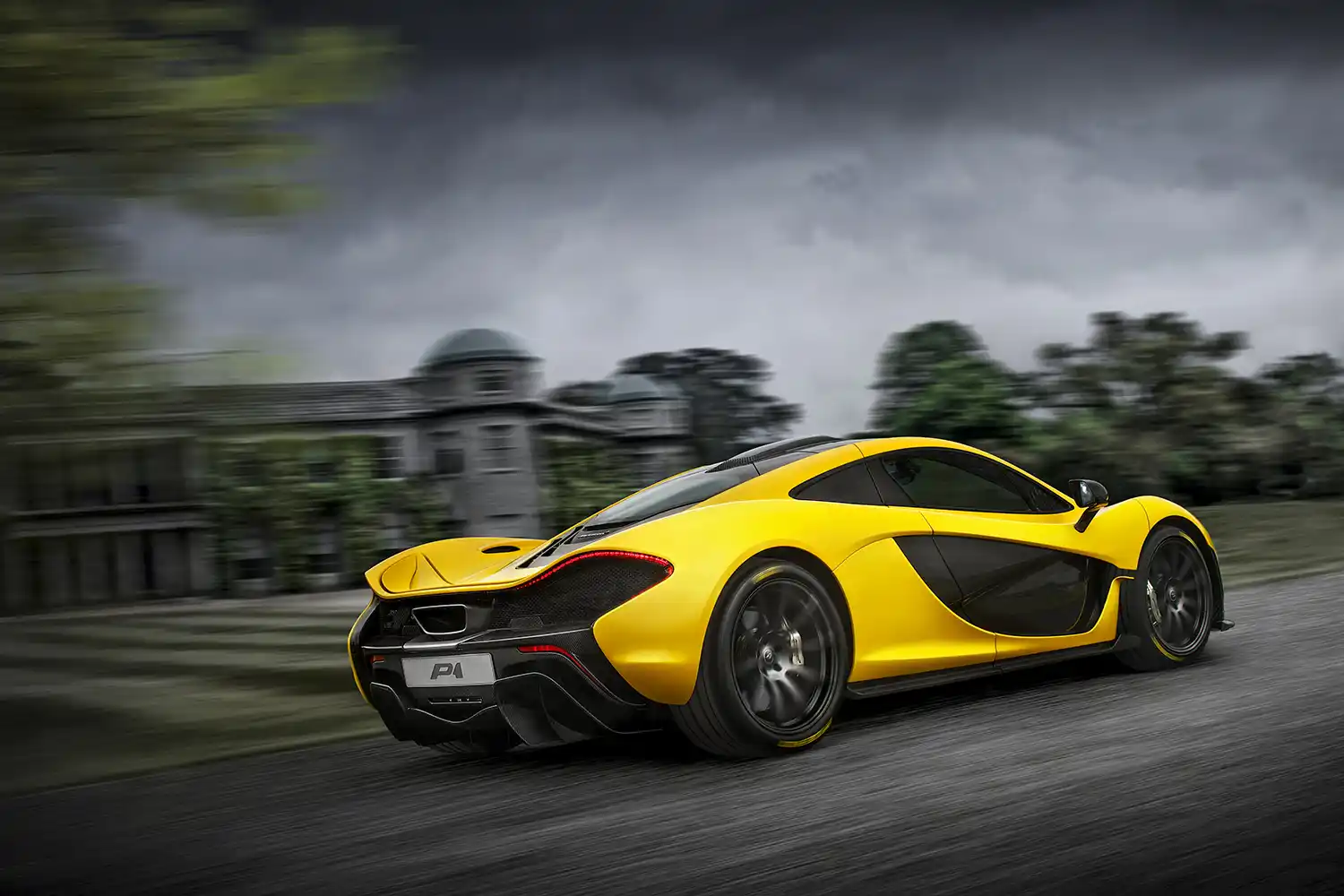
Roll stiffness changes by a factor of 3.5 between Normal and Race modes, while heave and pitch stiffness increases by a factor of 1.4.
Dan Parry-Williams explains, ‘The McLaren P1™ is very fast and capable as a road car. But in Race mode, it produces the same downforce as a Le Mans GT3 racing car.
‘It’s a tall order to change the aerodynamics and dynamics of a car, to make the suspension stiffer and to get closer to the road, all at the touch of a button, but that’s exactly what we have done. You don’t need a team of mechanics and a truck with different springs and dampers and wings in order to fully enjoy the McLaren P1™ on the track.’
Adds Parry-Williams: ‘A stiff, stable platform is essential when the car is in Race mode. You can’t have body roll or grounding, not when the downforce loads are that big. You can’t change the geometry of that space underneath the car, otherwise you shift the aero balance with serious effects at very high speed. You have to have extremely stiff springing and damping to cope.’
Wheels
Owing to the astonishing performance of the McLaren P1™, tailor-made wheels have had to be designed and developed. The 19-inch front and 20-inch rear wheels are made from a novel high strength aluminium alloy, and forged to a design which offers strength and lightness This is the first time that the material has been used for wheels on a production car, having previously been used for military applications.

The elegant 10-spoke design provides the most efficient weight/strength ratio. As with other areas of the McLaren P1™, a major focus was on optimising the weight of the wheels, resulting in the design weighing less than the 12C’s Super-lightweight optional wheels despite being wider. The 19x9J front wheels weigh 7.94kg each, while the rear 20×11.5J rims are 9.72kg. A single wheel design is available, in a silver or stealth finish.
Tyres developed with Pirelli
The tyres for the McLaren P1™ are specially developed P Zero Corsas, which have been developed with Pirelli, McLaren’s technology partner and sole tyre supplier. The team at Pirelli has been involved throughout the entire development programme of the McLaren P1™, and this has seen the tyre testing phase integrated into the entire schedule, as a key performance component. This has ensured the compound and construction has been developed and optimised during testing. The end result is a tyre that is finely tuned specifically to the performance and handling characteristics.
In order to develop tyres that complement the McLaren P1™’s characteristics, Pirelli called upon the experience gained in Formula 1 and all its other motorsport activities, also making use of computer simulations that replicate all usage conditions and stresses to which the tyres are subjected.
The construction of the tyres is much closer to a racing tyre than a conventional road car tyre. This is necessary to cope with the high loading due to the downforce in Race mode, and the specially formulated rubber has a much stiffer construction both vertically and laterally than normal high-speed sports car tyres.
Pirelli’s engineers have developed an innovative tyre solution capable of guaranteeing maximum stability and handling. The asymmetric design allows the tyre to remain sufficiently rigid even when subjected to different weight transfers, and ensures superior contact with the ground, even under cornering and braking, working in harmony with one of the most advanced suspension systems in the world. Despite this rigid compound, the tyre and suspension system have been developed together to ensure ride quality is not compromised in non-Race modes.
The tyre belt, bead and sidewall construction are all bespoke to suit the unique requirements of the McLaren P1™. Different structures were designed and developed for the front and rear tyres which ensure torque is cleanly transmitted and traction is optimised. In order to withstand high lateral forces of up to 2g through corners, the bead design on the rear tyres is also asymmetric.

The work carried out on the structures naturally also required the use of innovative compounds, utilising cutting-edge polymers, which improve stability and resistance to stress. Through the use of these compounds, the tyres now reach optimum operating temperature even more quickly, guaranteeing high grip levels and underlining the tyre’s rapid reaction to direction changes.
The tread pattern is a development of the Pirelli Corsa design, which has been enhanced to make the intersection of the inner sidewall and the tread have a specific aerodynamic profile, to boost the aero performance of the tyre.
These special asymmetric tyres come in one size only: 245/35ZR19 at the front and 315/30ZR20 at the rear.
Brake system by Akebono
The McLaren P1™ is designed to offer the same braking performance and capability of a GT3 or Le Mans sports racing car. They are a step ahead of any ‘supersports’ car sold today. Developed specially by McLaren’s Formula 1 partner Akebono, the system features a new type of ceramic carbon disc, never before used on a road car, but which has undergone some of the most demanding and extreme testing.
Prior to being used on the McLaren P1™, and in Formula 1, the material was first used on the Ariane space rocket programme for its heat-resistant qualities. Stronger than conventional carbon ceramic, this material dissipates heat more effectively, and can absorb 50 per cent more energy through the contact patch between the disc and the pad, than the carbon ceramic brakes on the 12C.
The carbon ceramic discs are infused with a surface layer rich in silicon-carbide – one of the hardest substances known to man. This specially developed highly durable ceramic layer coats the friction surfaces which not only gives superior stopping capabilities but also an attractive mirrored finish.

Akebono has applied Formula 1 technology and expertise throughout, and focused on each aspect of the brake systems and including materials, structure and surface processing, to ensure optimal performance in every area. This produces a highly reliable and efficient brake system that boasts significantly reduced weight, exceptional cooling capability, the ability to withstand high temperatures and maintain rigidity.
The brakes typically run cooler than conventional carbon ceramic but in extreme conditions – such as high-speed track work – they are able to run at very high temperatures without the degradation that would be experienced by conventional carbon ceramic discs. As a result of the discs being able to operate at higher temperatures, they can be smaller and lighter than would otherwise be required. The disc sizes are 390mm at the front, and 380mm at the rear.
The bespoke brake pads are produced in conjunction with Akebono, and mounted in Akebono aluminium monoblock opposed callipers, six-piston at the front and four-piston at the rear, which use Formula 1 technologies to deliver light weight and minimise drag.

The braking system has been fully tailor-made to meet the exacting requirements set out by the McLaren P1™, both in terms of performance and weight. Performance of the system is similar to a Le Mans racer, meaning the McLaren P1™ will stop at close to 2g, while offering a weight saving of more than 4kg. ‘Most “supersports” cars can suffer during braking on really fast circuits, such as Le Mans, Silverstone or Monza,’ says Chief Test Driver Chris Goodwin. ‘It’s because they just don’t have enough downforce. The McLaren P1™ has superb stopping power because of a braking system which works in conjunction with the downforce being produced.’
INTERIOR
The McLaren P1™ has a clear goal: to be the best driver’s car in the world on road and track. In order to achieve this, performance and handling are key, but to extract best from the aerodynamic bodyshape and the groundbreaking technology beneath the carbon fibre exterior, the driver has to feel comfortable and at ease. For this reason, the cabin of the McLaren P1™ is fully focused on the driver, and is clear from clutter and distraction. All examples of the McLaren P1™ will be produced in left-hand drive.
The interior of the McLaren P1™ offers the driver and passenger a cocooning, efficiently packaged, comfortable cabin. Light weight – as with the rest of the car – is a priority, yet the McLaren P1™ retains luxury features such as full climate control, satellite navigation and a bespoke sound system, developed from the outset with Meridian.

Director of Sales and Marketing for McLaren Automotive, Greg Levine explained: “As a company, McLaren Automotive prides itself on designing performance cars that their owners can use regularly, so the McLaren P1™ comes comprehensively equipped as standard with an array of colour and trim alternatives from which the customer will be able to choose as well as visible carbon fibre in the cabin. The options list is limited to only bespoke content that a customer might wish to add through McLaren Special Operations, and fitted luggage.”
Carbon fibre used extensively
Inside the two-seat cabin carbon fibre is used for the dashboard, floor, headlining, doors, rockers and a single piece is shaped for the central control unit to further optimise weight. It is the lightest possible material, while offering the strength desirable for safety and structural integrity. The attention to detail within the interior of the McLaren P1™ is such that, to further reduce weight, the top layer of resin has been removed, to leave the carbon non-lacquered with a more natural look…and save a further 1.5kg. This also reduces interior reflections.
The amount of trim covering within the cabin has been minimised, leaving as many parts as exposed as possible. There is no interior sound deadening in order to optimise weight saving even further. Carpet is offered, as an option, but when chosen, it is fitted with a special lightweight backing.

The racing bucket seats use the minimum amount of foam, are encased in ultra-thin carbon fibre shells, and mounted on lightweight brackets and runners, contributing to an overall weight of just 10.5kg each. The seat backs are set to 28 degrees from the vertical, and there is manual fore/aft adjustment. The decision was taken to not offer separate adjustment to the seat backs, or electric adjusters to the base, as these would have added further weight. The height of the seat will be custom set to suit the driver and passenger, and can be subsequently adjusted in the workshop. The seat back can be set to 32 degrees for racing, as it will give more helmet head room. Fixings for a six-point race harnesses are in place, in addition to the standard inertia reel seat belts.
Good visibility a priority
McLaren prioritises packaging – a key to efficient design – and good visibility, essential for a first-class driving experience. The interior of the McLaren P1™ feels like the cockpit of a fighter jet, complete with glass canopy overhead and, with a windscreen deeper than it is wide, visibility is optimised. Good side and rear visibility contrast with many other ‘supersports’ cars, which typically offer more a peek than a panorama. ‘Front visibility, in particular, is outstanding,’ says Chris Goodwin. ‘The impression is that the driver sits a long way forward, like in a Le Mans racer or a Formula 1 car. As with the 12C, the centre of the front wheels sits directly below the highest point on the front wings, enabling the driver to position the car precisely.’
The ‘shrink wrapped’ design theme extends to the cabin. There is no unnecessary padding or trim. Everything is there for a reason. ‘There is absolutely no flab in that cabin,’ points out Design Director Frank Stephenson. Switchgear is kept to a minimum, and only the DRS and IPAS buttons are on the ergonomically designed steering wheel.

To create the smallest frontal area possible, and help airflow to the large rear wing around the teardrop shaped canopy, the glasshouse of the McLaren P1™ has been made narrower, and driver and passenger are now brought 16mm inwards, compared with a 12C. To achieve this, driver and passenger are angled 1 degree away from the centre line. Thus, the weight of the driver and passenger are nearer the centre line of the car, reducing the polar moment of inertia which, in turn, allows easier changes of direction and greater agility. By being positioned closer to the centre line, the glass house design benefits aerodynamic performance.
Steering
The steering wheel diameter is as technically precise as a McLaren racing driver’s wheel. This is because past McLaren world champions’ grips were modelled on a CAD system and scanned to produce an exact replica. Both DRS and IPAS buttons are mounted on the wheel, as with a Formula 1 car, and the rim is finished in Alcantara (leather is available), with carbon fibre inserts.
As with the 12C, an electric hydraulic powered steering system is used. The electro-hydraulic pump is also used to provide the transition between road and Race modes.

Instrumentation
In front of the driver are three digital instrument screens, which provide all information about the car – 6.8-inch central screen, and two 3.0-inch outer screens. The instruments are built using TFT (thin film transistor) displays. There are four different displays on the main screen in front of the driver, depending on the driving mode. In electric, or E-mode, the amount of power being used and level of charge remaining are highlighted, as well as the speed displayed digitally. In Normal, Sport and Track modes, the tachometer and speed are given greatest prominence.
As the mode is changed to Race mode, the screen switches to a transition page. This shows a graphic of the vehicle lowering/raising, the rear wing extending/retracting, and the transmission, engine and tyres are highlighted as the systems are checked. These are illuminated green if functioning correctly, or red should a fault be detected.
In Race, there is a more race-focused display, including larger tachometer and powertrain temperature. The IPAS and DRS functions are also more prominent.
Stowage
The McLaren P1™ is two-seater but it is extremely efficiently packaged. The front storage compartment, part of the front single-piece clamshell carbon moulding, can store 120 litres of luggage – easily enough for two helmet bags. Further storage can be found behind the front seats in the form of two storage nets. There are stowage pockets on the front of the seats and three cup holders – two behind the centre console and one in the centre console.

MANUFACTURING
Production of the McLaren P1™ will be limited to 375 examples, and is to commence in the new £40 million McLaren Production Centre (MPC) facility in Woking, Surrey, UK, in 2013. Production will be alongside the production lines of the 12C and 12C Spider.
The MPC is adjacent to the McLaren Technology Centre, where the car was conceived (and where McLaren’s Formula 1 team is based). The manufacturing facility was opened in November 2011 by UK Prime Minister David Cameron and McLaren Group Chairman Ron Dennis.
